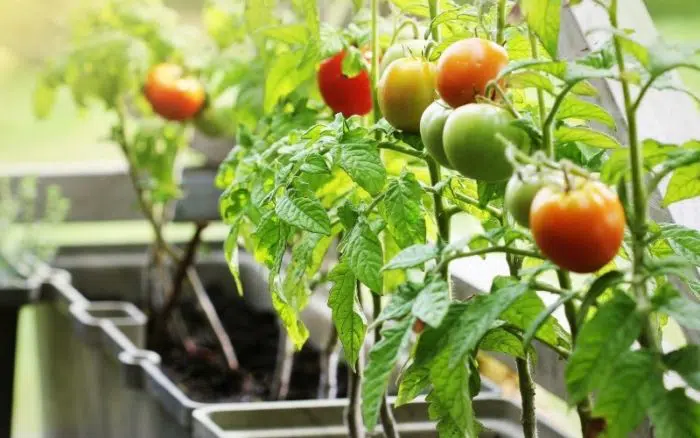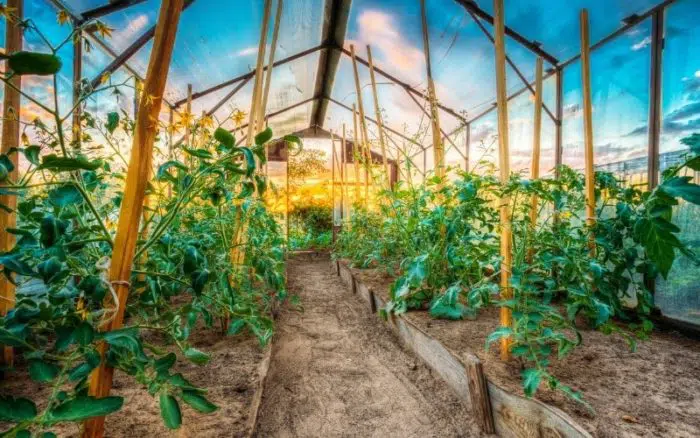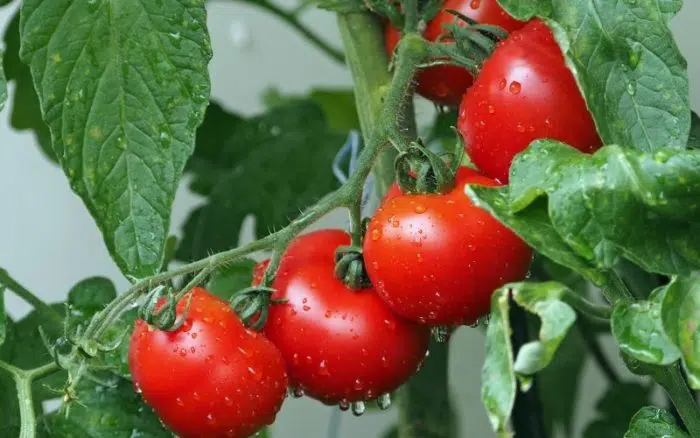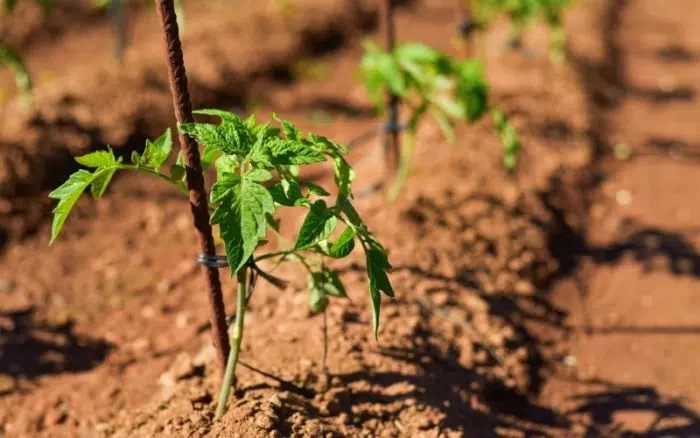Have you ever come out to the garden and noticed your tomato plants’ leaves are really drooping? It usually means they need more water than they’ve been getting that week.
When tomatoes aren’t watered properly, they aren’t able to take in as much calcium as they need. Oftentimes this leads to blossom end rot for the fruits that are forming at that point in time.
To keep this from happening much in the future, it’s a good idea to know how often they need to be watered.
Of course, the amount of water needed by tomato plants depends on a variety of factors, so let’s walk through multiple scenarios and figure out the right amount.
How Much to Water Tomato Plants
Tomatoes need around 1-2 inches (2.5-5 cm) of water per week. This amount should be adjusted based on the type of soil, weather conditions, and size of the plant.
If your tomato is inside, you should be fine watering it every other day after checking to make sure the top inch of soil isn’t still wet.
When you are watering tomato plants, drench the soil thoroughly so it sinks down far below the surface. But make sure your container has good drainage holes so the excess can run through.
How Often to Water Tomatoes
How often to water your tomato plant comes down its environment at the time. If it’s outside in the ground or in a pot, look to water it every 1-2 days, more if it’s really hot outside, but less if it’s raining a lot that week.
Whether you’re growing in-ground plants, or in a pot, or are starting seedlings, they are going to have different needs. Let’s take a look at each growing scenario for garden tomatoes.
Watering Tomatoes Seedlings and Tomato Plants Indoors
If you have your tomato seedlings indoors in a pot or container, you can generally water newly planted tomatoes it once every few days. The soil can dry out quickly in indoor settings, especially if it’s in a warmer room.
Keep the soil moist and warm, water as often as every three days. But also make sure the plant does not sit permanently in wet soil or this can cause overwatering issues (see below).

Watering Tomatoes in Pots
If your tomato is planted in a pot outside (even if it’s sitting by the door or on the patio), it will require more attention because of its climate. The sun’s rays are much stronger than the light it will get indoors, and that could cause the soil to dry out faster.
I like to use a method called deep watering, where you water plants fully and make sure the entire pot is wet. Usually, after a good watering, you can skip the following day (unless it’s going to be very hot).
If the weather is calling for a lot of rain, hold off on watering the plant so it doesn’t get too much water.
If the weather forecast is super dry and hot, make sure to check the plant daily (sometimes more than once per day) to see if it needs a drink of water.
With container grown tomato plants, you want to water often so the soil does not dry out completely, but be aware that overwatering can also damage the plant. Avoid watering after dark, as this could cause mildew to grow.

Watering Tomatoes in Raised Beds & in the Ground
If you have outdoor tomato plants in raised beds or in the ground, you usually only need to water them every few days unless there are extreme heat conditions. Depending on where you live, your tomato plants can often see quite a bit of rain during parts of the season.
If you live in a more dry area or are experiencing weeks where there is no rain in sight, you’ll want to check your tomato plant daily to make sure it doesn’t need water.
With tender plants that are younger, they often do best getting watered more regularly. Check on them daily to make sure they are doing alright.
With a more mature, full-grown tomato plant, they are hardier and can usually go a few days without being watered. However, if the weather is very warm and dry, check on them daily.
When overhead watering, be sure to use your hose nozzle on the lowest setting or invest in an inexpensive watering wand that helps with accuracy. You want to water the ground and tomato plants slowly, not wetting the leaves themselves.
Tomatoes can run into a few issues if its leaves get and stay wet, this is especially common if you end up watering your plant closer to the end of the day or at night. The leaves won’t have time to dry out and this can introduce pests and diseases to take root.
- Made with aluminum making it lightweight, yet durable
- Rubber foam along the wand for additional protection at the natural wearing point.
Add Mulch to Your Garden
When growing tomato plants in the ground, you can save yourself a lot of hassle by mulching around the plants.
This helps reduce evaporation and keeps the soil from getting too warm so your tomato plants don’t dry out too quickly. But also it won’t send the tomato plant into shock if temperatures fall.
Another added benefit of organic mulch is that is reduces the splash-back effect and helps prevent dirt and possible disease from splashing up onto the leaves when it gets watered or it rains.
Add 1-2 inches of cedar mulch (my favorite), leaf mulch, straw/hay, or other kinds of mulch.
Drip Irrigation System
You can also cheat the system and use a drip irrigation system, which essentially can take most of the guesswork out of when to water tomato plants.
You essentially hook the system up to your hose and it automatically drips out water regularly throughout the day. You can really get crazy and get an automated one that will stop watering when it rains.

How to Tell if Tomato Plants Need Water
There are a few ways to check if your tomato plants need to be watered.
Look for Wilting Leaves
Oftentimes, when tomato needs water it will tell you. No, it won’t say anything out loud, but actions speak louder than words anyway right? 😉
Tomato leaves are one of the first things to show signs of drying out. So its leaves will often look like this and that’s a sign to you that you need to give that bad boy a drink.
Test the Soil with Your Finger
You can also check the top inch or so of the soil surface. If it’s dry and you don’t feel water an inch down, go ahead and water it.
If you can feel any kind of soil moisture, it’s probably best to wait a day so you don’t overwater your tomato.

Can you Water Tomatoes Too Much?
Yes, there is a way you might be watering tomato plants too much. Overwatering your plants consistently can even lead to blossom end rot, which is not good for fruit production. If you’ve had problems with overwatering in the past, you can water with a spray bottle to make sure you’re not drowning the tomato plants.
How Many Times a Week Should You Water Tomatoes?
You want to be maintaining consistent soil moisture, but not letting your plants be constantly wet. A little moisture is nice to keep around your tomato plants.
How often to Fertilize Tomatoes?
Tomato fertilizer can be added every 1-2 weeks during the growing season to potted tomato plants and container-grown tomato plants alike.
Whether you’re growing cherry tomatoes or Roma tomato plants in small containers, getting the proper watering schedule right is critical. Overwatering can lead to root rot and blossom end rot for your tomato plants, but underwatering can lead to stunted growth and minimal fruit production.



